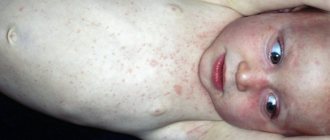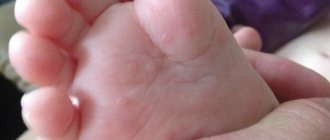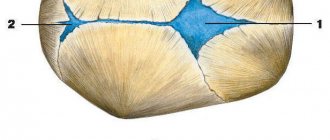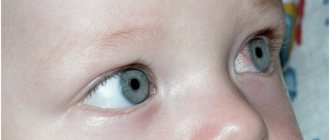A baby is the most important treasure in every woman’s life. The pregnant mother carries him, cherishes him, protects him. Many of us have heard of sudden infant death syndrome. It is sometimes called “cradle death” because babies die in their sleep. But not everyone knows what it is, as well as the reasons for its occurrence. And everyone knows that what we know less about always seems more terrible. It's the same with sudden infant death syndrome.
Every woman knows either minimally or not at all about this phenomenon. This syndrome is the main cause of death of babies from birth to the first year of life, not only in our country, but throughout the world. Over the years, scientists have conducted many studies of this phenomenon, but they have not been able to accurately answer the question: why babies die. A child who has no health problems goes to bed peacefully and at one moment, without any reason, simply dies and never wakes up.
Just the thought that your baby, being healthy, will stop breathing while sleeping and will not wake up again, horrifies even the most courageous parents. But, nevertheless, fear should not give a reason to turn a blind eye to a possible threat to the life of your baby.
It is necessary to do everything so that your behavior as parents can prevent such a terrible syndrome. Sometimes people are mistaken in thinking that an unknown danger cannot be prevented.
What is sudden infant death syndrome?
Most sudden infant deaths occur between midnight and 6 a.m.
This syndrome (SIDS) is characterized by the sudden death of an infant. It is sometimes called sudden infant death syndrome or cot death. Its key feature is death without any compelling reason. This excludes the presence of congenital diseases, accidents, infections or acquired ailments that could provoke the rapid death of the child.
We can talk about sudden infant death syndrome if it was not possible to establish the cause of death as a result of studying medical documentation, autopsy data and inspection of the place of death.
This syndrome occurs extremely rarely, ranging from 0.1 to one and a half cases per 1000 infants. According to the results of recent studies, children aged 2-4 months are at risk. It is at this age that the greatest number of deaths occur. 60% of deaths occur among boys. After 8 months of age, the risk of sudden death decreases.
Sudden infant death usually occurs between midnight and 6 am, more often in the winter season. Today, the share of this syndrome among all infant deaths under one year of age is 30%.
Risk factors
In the course of studying cases of sudden infant death syndrome, the following risk factors were identified:
- during sleep, the baby lies on his stomach;
- soft bedding is used for the child;
- the baby was born premature;
- Using too warm blankets and excessive heating, which leads to overheating of the child;
- presence in the family of cases of stillbirth or sudden death syndrome;
- lack of medical monitoring of pregnancy or its late onset;
- development of depression in the mother during pregnancy;
- smoking, alcoholism, drug use by mother;
- poor economic situation of the family;
- the mother was under 17 years of age.
Women who smoke during pregnancy increases their risk of developing SIDS by 40%. In this case, we are talking not only about active, but also about passive smoking. After the baby is born, even smoking in the next room with the window open can cause harm to it.
Prevention
Although there is no guaranteed way to prevent SIDS, parents should take several protective measures to reduce the risk of an unexpected incident.
1. Place your baby to sleep on his back:
- A baby is at greater risk for SIDS when sleeping on their side or stomach. During this position, the baby's face rests heavily on the mattress, and he cannot breathe freely;
- Make sure that the baby's head is uncovered, and it is better to place the sleeping baby on his back. This helps him breathe more comfortably.
2. Keep the crib clean and tidy:
- Do not leave soft toys or pillows in the baby's crib, as this will interfere with the baby's breathing when the baby's face is pressed against these objects.
3. Avoid overheating your baby:
- It is advisable to use a sleeping bag or light blankets to keep the child warm;
- do not use any additional coverings or cover the child’s face when he sleeps;
- when covering the baby with fluffy blankets, since the child makes many unconscious movements and the blanket can suffocate him;
- choose small blankets and place them at the foot of the mattress so that it covers the child’s shoulders;
- swaddling or wrapping a baby in fluffy and thick coverings makes him feel uncomfortable and makes breathing difficult;
- an overheated child experiences anxiety and cannot tolerate high body temperature for a long period of time.
4. Breastfeeding is very beneficial:
- breastfeeding improves the child’s immunity and protects him from respiratory tract infections;
- It is advisable to breastfeed your baby for at least six months, which effectively reduces the risk of SIDS.
5.Pacifier suggestion:
- sucking a pacifier while sleeping effectively eliminates the risk of SIDS;
- but if the baby is not interested in the nipple, you should not force him;
- Place the pacifier in your baby's mouth before bedtime. But don't put it in his mouth after he falls asleep;
- Keep the pacifier clean to prevent harmful germs from entering your baby's body.
6. Don't smoke around your baby:
- parents who smoke should give up their addiction before and after the birth of their child;
- passive smoking often leads to suffocation of an infant;
- Babies born to mothers who smoke are at greater risk of SIDS.
7. Ensure your child sleeps on a hard surface:
- always place your child to sleep on a hard surface;
- do not place the child on the sofa, between the pillows;
- When your baby falls asleep in a carrier, try putting him on a firm mattress as soon as possible.
8. Prenatal care:
- Early and regular prenatal care is effective in reducing the risk of SIDS;
- follow a balanced diet;
- The mother needs to undergo frequent medical examinations throughout pregnancy. This will ensure early diagnosis of any abnormalities in the growing fetus. Brain pathologies often lead to SIDS;
- Regular health checks also reduce the risk of preterm birth or low birth weight.
9. Regular pediatric examination and immunization:
- When a child appears sick or has trouble breathing, consult a doctor immediately;
- It is necessary to vaccinate the child according to the schedule. Immunization protects him from life-threatening diseases;
- studies show that vaccinating a child within the specified time limits reduces the risk of SIDS;
- If your child experiences apnea, take him to the doctor immediately. The doctor examines health problems and takes the necessary treatment procedures.
Causes
Since SIDS is currently an unstudied phenomenon, it is not possible to establish the specific causes of its occurrence. However, scientists have put forward several assumptions regarding possible provoking factors.
Respiratory dysfunction
According to statistics, about 82% of dead children diagnosed with sudden death syndrome died in their sleep, 70% of them lying on their stomachs face down or to the side
During sleep, a person may periodically experience shortness of breath when it stops for a moment. Such stops in respiratory activity do not indicate any abnormality. Usually, in the absence of breathing, oxygen starvation occurs, called hypoxia. When there is a lack of oxygen in the blood (hypoxemia), this leads to the awakening of the sleeper and the restoration of breathing. If this does not happen, death occurs.
Such pauses in breathing during sleep are called apnea and are quite common in infants. This is explained by the immaturity of regulatory mechanisms. However, if your child holds his breath for more than 15 seconds, you should contact your pediatrician. Frequent apnea (more than one event per hour) is also an alarming symptom.
Pathologies of the brain stem
The vasomotor and respiratory centers are located in the medulla oblongata. When the body is exposed to tobacco smoke, it presumably stimulates the synthesis of enzymes that contribute to the occurrence of sudden infant death syndrome.
Recent studies have revealed the presence of changes in the cellular structure in the brain stem in children who died from SIDS. Similar disturbances occurred during intrauterine development due to hypoxia.
Children who were saved after sudden respiratory arrest underwent ultrasound echography, which made it possible to identify pathologies of the cerebral arteries in 50% of such patients. Thus, cerebrovascular accidents were identified as a possible cause of sudden death.
Blood circulation may be impaired in a certain position of the child's head when the vertebral artery is compressed. Due to insufficient development of the neck muscles, it is still quite difficult for a small child to turn his head independently. Only from four months do children gain the ability to freely turn their heads, doing this naturally and safely.
Deterioration of cerebral blood supply in infants is observed due to sleeping on the side. However, blood flow to the brain is even more impeded when lying on your stomach. Studies have shown that in such cases the baby has a weak pulse and sharply slow breathing.
Heart problems
A short-term cessation of heartbeat can be detected in a healthy child, but such a symptom requires immediate contact with a specialist
According to some scientists, the greatest danger to the development of SIDS is not apnea, but a violation of the heart. In particular, we are talking about asystole, or cardiac arrest.
Risk factors in this case are:
- extrasystolar rhythm disturbances;
- decreased number of heart contractions (less than 70 beats per minute);
- identification of blockades on the electrocardiogram;
- frequent changes in heart rate.
Sudden infant death syndrome often develops due to a mutation in the gene that is responsible for the structure of sodium channels in the heart muscle. Due to the changes observed in these structures, heart rhythm disturbances occur. Despite the fact that a short-term cessation of heartbeat can be detected in a healthy child, this symptom requires immediate contact with a specialist.
Stress
There is a lot of evidence confirming the relationship between SIDS and severe stress experienced by the child. Nonspecific stress syndrome can lead to the following changes in the baby’s body:
- minor hemorrhages in the lungs and thymus gland;
- decreased blood viscosity;
- ulceration of the mucous membrane of the digestive tract.
Is swaddling a baby a risk factor?
Experts have different opinions. Some of them believe that it is necessary to swaddle the baby, because he will not be able to roll over and cover his head with a blanket, which means that the risk of SIDS is less.
Proponents of the opposite opinion argue that swaddling interferes with the development of the baby's physiological maturity. Due to tight swaddling, restrictions in movements arise (the child cannot take a comfortable position), which disrupts thermoregulation processes: heat transfer from the body increases in a straightened position.
Breathing is also limited, which means swaddling increases the risk of pneumonia and SIDS, and subsequently the child’s speech develops worse. With tight swaddling, the baby will have less close contact with his mother, which is also important for his development.
Symptoms
Since sudden infant death syndrome occurs without any prerequisites, it is very difficult to determine the symptoms in this case. There are only indicative data that you should pay attention to:
- Lack of breathing during sleep for more than 15 seconds.
- Heart rhythm problems.
- Anxiety, weight loss, eye discharge and rash.
- Enlarged liver, spleen and tonsils.
The above symptoms in one form or another occur in 90% of children a couple of weeks before the development of sudden infant death syndrome. Therefore, parents are advised to consult a pediatrician if such symptoms are detected in their child.
Diagnostics
Polysomnography is a very important step in the diagnosis of sudden infant death syndrome (SIDS)
To assess the risk of developing sudden infant death syndrome, the following methods are used:
- ECG. A classic diagnostic method that allows you to identify possible malfunctions of the heart. The procedure is accessible, informative and completely painless.
- Magdeburg points table. A test algorithm that is designed to calculate the individual statistical risk of developing sudden infant death syndrome.
- Polysomnography. A procedure involving a sleep study. For this purpose, special computer systems are used. The patient is connected to devices that record various indicators of his body during sleep. The technique is a very important stage in the diagnosis of SIDS.
Is it possible to prevent SIDS?
- Previously, doctors considered a theory related to the suffocation of a baby during the period of mother and child sleeping together. According to some sources, this information is irrelevant. On the contrary, many scientists believe that co-sleeping is a preventative measure for SIDS. During sleep, the baby's breathing and heartbeat are synchronized with those of the mother. In addition, the mother can monitor the child’s sleep and respond in time in case of unexpected danger.
- Avoid co-sleeping if you are intoxicated, tired, or taking sedatives.
- You should not cover a one-year-old child with a blanket; it is better to dress him warmer. The pillow is not suitable for a baby. Use only firm mattresses recommended by orthopedists and pediatricians.
- Stop smoking in the house. Tobacco smoke is unacceptable for a child.
- There should be no unnecessary objects in the crib during sleep.
- Place the baby on his back and turn his head slightly to the side. Sleeping on your stomach is unacceptable.
- It is also unacceptable to place the child on a soft mattress and use a blanket and pillow.











